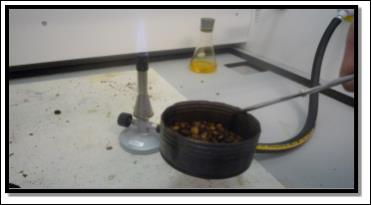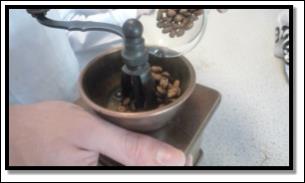This Module Consists of Six Parts

Module:Coffee
1. Introduction
This module consists of six parts
- Exchange form
- General information & history
- Quick scan about coffee customs
- Preparation to the competition
- Coffee beans roasting competition
- Teacher notes
2. Exchange Form
TO:
DateTeacher’s name
School
Address
Phone numbers
(inc. dialling code) / Telephone:
Fax:
E-mail address
School website address
We understand that your class is studying Coffee. We would like to exchange information and the results of our own experiments and research.
We look forward to hearing from your class. Please reply.
FROM:
Teacher’s nameSchool
Address
Phone numbers
(inc. dialling code) / Telephone:
Fax:
E-mail address
School website address
3. Information and activity sheets
- General information & history
Coffee is a drink prepared from roasted coffee beans. Coffee beans come from the coffee plant. Coffee beans are found in coffee cherries, which grow on the coffee plants. These plants can grow up to 5 meters, and grow large leaves. The flowers are white in colour, and the berries they produce start off green, and then turn yellow before turning dark red, and eventually black. Coffee plants grow in over 70 countries. They are very common in Latin America, Southeast Asia, and Africa. Coffee can have a stimulating effect on humans due to its high caffeine content. It is one of the most consumed drinks in the world.
 Coffee has played an important role in many societies. The effect of the coffee bean plant is thought to have been discovered in Ethiopia. The cultivation of coffee started first around Arabia.
Coffee has played an important role in many societies. The effect of the coffee bean plant is thought to have been discovered in Ethiopia. The cultivation of coffee started first around Arabia.
The earliest evidence of coffee drinking is from the 15th century, in southern Arabia. From the Muslim world, coffee spread to Italy, and then to the rest of Europe, Indonesia, and to the Americas. Several times throughout history coffee was banned in countries, either due to political or religious reasons.
The coffee berries, which contain the coffee seed/bean, are produced by several plants from the genus Coffea. The two most commonly grown are known as Coffea Arabica, and CoffeaCanephora. The latter is resistant to coffee leaf rust (Hemileiavastatrix), a disease affecting coffee plants. Once ripe, the coffee berries are picked and dried. The seeds are then roasted at various degrees, depending on the desired flavour. After the roasting process the coffee beans are ground. Coffee can be prepared and presented in all sorts of ways.
Degree of roast pictorial
/ 22 °C (72°F) Green BeansGreen coffee beans as they arrive at the dock. They can be stored for up to two years. / / 165 °C (329°F) Drying Phase
As beans roast, they lose water and increase in size. Arabic coffee is prepared using this roast.
/ 195 °C (383°F) Cinnamon Roast
The lightest drinkable roast, immediately before first crack. Light brown, toasted grain flavours with sharp acidic tones. / / 205 °C (401°F) New England Roast
Moderate light brown, still acidic but not bready, a traditional roast for Northeastern U.S. Coffee, at first crack.
/ 210 °C (410°F) American Roast
Medium light brown, the traditional roast for the Eastern U.S. First crack ending. / / 220 °C (428°F) City Roast
Medium brown, the norm for most of the U.S., good for tasting the varietal character of a bean.
/ 225 °C (437°F) Full City Roast
Medium dark brown with occasional oil sheen, good for varietal character and bittersweet flavors. At the beginning of second crack. / / 230 °C (446°F) Vienna Roast
Moderate dark brown with light surface oil, more bittersweet, caramel-y flavor, acidity muted. In the middle of second crack. Occasionally used for espresso blends.
/ 240 °C (464°F) French Roast
Dark brown, shiny with oil, burnt undertones, acidity diminished. At the end of second crack. A popular roast for espresso blends. / / 245 °C (473°F) Italian Roast
Very dark brown and shiny, burnt tones become more distinct, acidity almost gone, thin body. The common roast for espresso blends.
/ 250 °C (482°F) Spanish Roast
Extremely dark brown, nearly black and very shiny, charcoal and tar tones dominate, flat, with thin body.
b.Quick scan of coffee customs
Bovenkant formulier
question 1
How often do you drink coffee?
more than once a day
once a day
more than once a week
once a week
once a month
more than once a month
hardly ever
never
Onderkant formulier
/
Bovenkant formulier
Question 2
Why do you drink coffee?
to relax
everyone else around you does it
it is part of your daily routine
to keep your energy levels up
you feel you are addicted to it
you don't know why
to socialise
because you like the taste
Onderkant formulier
/
Bovenkant formulier
Question 3
what age group do you belong to?
under 15
15-20
20-25
30-35
35-40
40-45
45-50
over 50
Onderkant formulier
/
Bovenkant formulier
Question 4
would you say that coffee is an important part of you culture? please tick one box.
YES
NO
Onderkant formulier
Bovenkant formulier
Question 5
What would you say is your most preferred coffee brand ?
Nescafe
Espresso
Kenco
Neither
Onderkant formulier
Bovenkant formulier
Question 9
In your opinion, how often do you think you should drink coffee?
more than once a day
once a day
more than once a week
Once a month
More than once a month
Hardly ever
Never
Onderkant formulier
/
Bovenkant formulier
Question 6
Would you say that coffee is an important part of British culture ?
Yes
No
Onderkant formulier
/
Bovenkant formulier
Question 7
In what occasion would you say you are most likely to consume coffee?
When watching television
After a meal
At work
When socialising
When you have nothing else to do
Onderkant formulier
/
Bovenkant formulier
Question 8
Do you think coffee is bad for your health?
Yes
No
Onderkant formulier
- Preparation to the competition- Roasting temperature
As you may know, coffee beans need a certain temperature to roast properly. In this experiment we are going to try to find the perfect temperature.
Materials:
- Unroasted coffee beans (to buy on internet).
- Three heat resistant metal tins with the same amount of coffee beans
- A Bunsen burner
- Thermometer
- A pair of tweezers
Instructions
- Prepare three tins with the same amount of coffee beans.
- Number the tins from one to three.
- Heat the first tin to 200°C.
- Put the beans in the tin and keep shaking them for two minutes.
- Repeat step three and four but now heat to225°C and 250°C.
- Count all the raw, roasted and burned beans and place the results in the table.
Realize that caffeine content varies by roast level.
Caffeine decreases with increased roasting level: light roast, 1.37%; medium roast, 1.31%; and dark roast, 1.31%
Different grinding and brewing methods can affect the amount of caffeine present.

Questionnaire:
Which tin has the most raw beans?
Bin:____
Which tin has the most well roasted beans?
Bin:____
Which tin has the most burned beans?
Bin:____
What is the best temperature for roasting coffee beans?
____ °C
Use this temperature for the real roasting process.
- The coffee beans roasting competition
All partners have to do these actions:
- Buy unroasted coffee beans on the internet.
- Get yourself a metal, heat resistant tin.
- Search for a pair of heat resistant tweezers.
- Get a bunsen burner.
- Ask your parents for an old coffee grinder.
- Buy some coffee filters and a funnel.
- Fetch some cups to put your roasted beans in when the roasting process is finished and to boil water.
Roasting:
- Put the unroasted coffee beans in the metal tin, and start roasting them on a fire (Bunsen Burner!) . Make sure that the beans will not get too dark. Therefore, it is very important to shake the tin while roasting.
- The roasting may take a few minutes.
- When the beans are brown and you think they are done, remove the coffee beans from the tin and throw them into one of your cups.
 Do not keep the beans in the tin! As the tin is still hot, the beans might burn.
Do not keep the beans in the tin! As the tin is still hot, the beans might burn.
- Send some roasted beans to each of your partners, preferably in vacuum conditions.
After receiving the beans of the partners you have to grind each sample separately and make coffee of it.
Grinding:
 When the roasting is done, put the coffee beans in a coffee grinder. (Manual grinders work better than electric ones!)
When the roasting is done, put the coffee beans in a coffee grinder. (Manual grinders work better than electric ones!)- While grinding, boil water in a cup above the bunsen burner. (The amount of water you use is up to you; it will affect the taste of your coffee)
- Now you have coffee powder.
Making coffee:
- Put a coffee filter into a funnel. Place it on top of a beaker.
- Put your coffee powder into a coffee filter..
- Pour hot water (boiled during the grinding process) into the filter. Now you are extracting coffee!
- The liquid trickling into the beaker is called coffee!
- Create a tasting panel to judge the coffees of the partners. In the end each coffee gets a mark.
The schemebelow can be used:

After each participant has given marks to the coffees of the partners, gather the marks.
By calculating the average of the results of the partners you will get a winner.The Royal coffee beans roasting team

4.Teachers notes
The strong aspect of this module is the combination of a theoretical part (general information &history) and a practical part (beans roasting and competition).
Theoretical part
no special remarks are needed
Practical part
Materials
- The raw beans are offered by many firms on internet and will cost about €20 for one kg.
- The roasting equipment are part of the basic materials of the physic /chemistry lab of schools.
- If a coffee grinder is not available this can be replaced by a vat mortar also from the lab.
- The coffee filter can be derived from a common electric coffee machine.
The roasting process is very delicate, time, temperature and stirring of the beans are very critical and have to be exercised.
Organisation
- Competition, do it by means of a group session on Skype. Be inspired by the European Song Festival, especially the voting part makes it special and will create much communication, the aim of our project.
Look also to our public website:
This module is created within Comenius Project Chemistry as Cultural Enterprice (CCE)
 Do not keep the beans in the tin! As the tin is still hot, the beans might burn.
Do not keep the beans in the tin! As the tin is still hot, the beans might burn. When the roasting is done, put the coffee beans in a coffee grinder. (Manual grinders work better than electric ones!)
When the roasting is done, put the coffee beans in a coffee grinder. (Manual grinders work better than electric ones!)